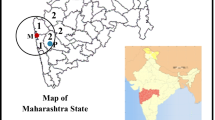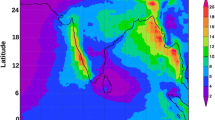Abstract
Ten-year climatology of physical properties of convective echoes during pre-monsoon season over south peninsular India and neighborhood are studied using Precipitation Radar dataset onboard Tropical Rainfall Measuring Mission satellite. Attenuation corrected radar reflectivity (Ze) is used to define an intense convective echo (ICE) which is a group of two or more contiguous convective pixels with Ze exceeding 30 dBZ. Height distribution of ICE is right skewed, single modal with mean and median as 7.8 and 7.3 kms. The ICE with area in range of more than 102 to 103 km2 (C) are most frequent (58.5%) followed by smallest scale (D) having area ≤ 102 km2 (37.2%). Large ICE’s (B/C scale) are less frequent (4.2%). Mean areas of ICE’s in D, C and B/C scales are 72.7, 279 and 1932 km2, respectively. The relation between height and area is linear indicating that taller ICE’s are broader. The mean top heights of D, C and B/C scales are 5.5, 8.7 and 14.2 km, respectively. Frequency distributions of the height of 30 and 40 dBZ show single peaks at 5.5 and 4.75 km. Mean heights of 30 dBZ and 40 dBZ are 5.7 and 4.8 km while median heights are 5.5 and 4.7 km. Their cumulative frequency distribution shows that 6 and 3% of ICE cross 10 km height. Reflectivity structures of ICE show that systems over land are intense compared to that over ocean.










Similar content being viewed by others
References
Awaka J, Iguchi T, Kumagai H, Okamoto K (1997) Rain type classification algorithm for TRMM precipitation radar. In: Proceedings international geoscience and remote sensing symposium Singapore Institute of Electrical and Electronics Engineers, pp 1633–1635
Alcala CM, Dessler AE (2002) Observations of deep convection in the tropics using the tropical rainfall measuring mission (TRMM) precipitation radar. J Geophys Res 107(D24):4792. https://doi.org/10.1029/2002JD002457
Barnes HC, Houze RA Jr (2013) The precipitating cloud population of the Madden–Julian oscillation over the Indian and west Pacific Oceans. J Geophys Res Atmos 118:6996–7023
Bhat GS, Kumar S (2015) Vertical structure of cumulonimbus towers and intense convective clouds over the South Asian region during the summer monsoon season. J Geophys Res Atmos 120:1710–1722
Cecil DJ, Goodman SJ, Boccippio DJ, Zipser EJ, Nesbitt EW (2005) Three years of TRMM precipitation features. Part I: Radar, radiometric, and lightning characteristics. Mon Weather Rev 133:543–566
Chaudhari HS, Ranalkar MR, Kumkar YV, Jai HO, Singh GP (2010) Study of lightning activity over Indian subcontinent. Adv Geosci 16:121–131
Christian HJ, Blakeslee RJ, Goodman SJ , Douglas AM, Stewart MF, Buechler DE, Koshak WJ, Hall JM, Boeck WL, Driscoll KL, Boccippio DJ (1999) The lightning imaging sensor. In: Procedings of 11th international conference on atmospheric electricity, Guntersville, AL, pp 746–749
Dee DP, Uppala SM, Simmons AJ, Berrisford P, Poli P, Kobayashi S, Andrae U, Balmaseda MA, Balsamo G, Bauer P, Bechtold P, Beljaars M, Van de Berg L, Bidlot J et al (2011) The ERA-Interim reanalysis: configuration and performance of the data assimilation system. Q J R Meteorol Soc 137:553–597
Dalal S, Lohar D, Sarkar S, Sadhukhan I, Debnath GC (2012) Organizational modes of squall-type mesoscale convective systems during premonsoon season over eastern India. Atmos Res 106:120–138
Das S, Sarkar A, Das MK, Rahman MM, Nazrul MI (2015) Composite characteristics of Norwesters based on observations and simulations. Atmos Res 158–159:158–178
Dixon M, Weiner G (1993) TITAN: thunderstorm identification, tracking, analysis, and nowcasting—a radar-based methodology. J Atmos Ocean Technol 10:785–797
Houze RA Jr, Cheng CP (1977) Radar characteristics of tropical convection observed during GATE: Mean properties and trends over the summer season. Mon Weather Rev 105:964–980
Houze RA Jr (2004) Mesoscale convective systems. Rev Geophys. https://doi.org/10.1029/2004RG000150
Houze RA Jr, Wilton DC, Smull BF (2007) Monsoon convection in the Himalayan region as seen by the TRMM precipitation radar. Q J R Meteorol Soc 133:1389–1411
Houze RA Jr, Rasmussen KL, Zuluaga MD, Brodzik SR (2015) The variable nature of convection in the tropics and subtropics: a legacy of 16 years of the Tropical Rainfall Measuring Mission satellite. Rev Geophys. https://doi.org/10.1002/2015RG000488
Iguchi T, Kozu T, Meneghini R, Awaka J, Okamoto K (2000) Rain-profiling algorithm for the TRMM precipitation radar. J Appl Meteorol 39:2038–2052
Johnson RH, Rickenbach TM, Rutledge SA, Ciesielski PA, Schubert WH (1999) Trimodal characteristics of tropical convection. J Clim 12:2397–2418
Kodama YM, Okabe H, Tomisaka Y, Kotono K, Kondo Y, Kasuya H (2006) Lightning frequency and microphysical properties of precipitating clouds over the Western North Pacific during Winter as derived from TRMM multisensor observations. Mon Weather Rev 135:2226–2241
Kumar KK, Jain AR, Rao DN (2005) VHF/UHF radar observations of tropical mesoscale convective systems over southern India. Ann Geophys 23:1673–1683
Kumar S, Bhat GS (2016) Vertical profiles of radar reflectivity factor in intense convective clouds in the tropics. J Appl Meteorol Climatol 55:1277–1286
Kummerow C, Barnes W, Kozu T, Shiue J, Simpson J (1998) The tropical rainfall measuring mission (TRMM) sensor package. J Atmos Ocean Technol 15:809–817
Liu C, Zipser ED, Cecil DJ, Nesbitt SW, Sherwood S (2008) A cloud and precipitation feature database from nine years of TRMM observations. J Appl Meteorol Climatol 47:2712–2728
Liu C (2011) Rainfall contributions from precipitation systems with different sizes, convective intensities and durations over the tropics and subtropics. J Hydrometeorol 12:394–412
Lopez RE (1976) Radar characteristics of the cloud populations of tropical disturbances in the Northwest Atlantic. Mon Weather Rev 104:268–283
Morwal SB, Narkhedkar SG, Padmakumari B, Maheskumar RS, Kothawale DR, Dani KK, Burger R, Bruintjes RT, Kulkarni JR (2015) Cloud characteristics over the rain-shadow region of north central peninsular India during monsoon withdrawal and post-withdrawal periods. Clim Dyn. https://doi.org/10.1007/s00382-015-2595-0
Mukhopadhyay P, Mahakur M, Singh HAK (2009) Interaction of large scale and mesoscale environment leading to formation of intense thunderstorms over Kolkata Part I: Doppler radar and satellite observations. J Earth Syst Sci 118:441–466
Qie X, Wu X, Yuan T, Bian J, Lu D (2014) Comprehensive pattern of deep convective systems over the Tibetan Plateau-South Asian monsoon region based on TRMM data. J Clim 27:6612–6626
Raghavan S, Sivaramakrishnan TR, Ramakrishnan B (1983) Size distribution of radar echoes as an indicator of growth mechanisms in monsoon clouds around Madras. J Atmos Sci 40:428–434
Rapp A, Peterson AG (2014) Climatology of storm characteristics in Costa Rica using the TRMM precipitation radar. J Hydrometeorol 15:2615–2633
Romatschke U, Medina S, Houze RA Jr (2010) Regional, seasonal, and diurnal variations of extreme convection in the South Asian region. J Clim 23:419–439
Romatschke U, Houze RA Jr (2011) Characteristics of precipitating convective systems in the premonsoon season of South Asia. J Hydrometeorol 12:157–180
Shrestha D, Singh P, Nakamura K (2012) Spatiotemporal variation of rainfall over the central Himalayan region revealed by TRMM Precipitation Radar. J Geophys Res 117:D22106
Sreelekha PN, Babu CA (2018) Organized convection over southwest peninsular India during the pre-monsoon season. Theoret Appl Climatol. https://doi.org/10.1007/s00704-018-2446-0
Thomas SIT, Raghvendra VK (1977) Heights of cumulonimbus tops over the Deccan Plateau and adjoining plains of Andhra Pradesh and east Maharashtra: a radar study. Indian J Meteorol Hydrol Geophys 28:479–482
Tyagi A (2007) Thunderstorm climatology over Indian region. Mausam 58(2):189–212
Tyagi A, Sikka DR, Goyal S, Bhowmik M (2012) A satellite based study of pre-monsoon thunderstorms (Norwesters) over eastern India and their organization into mesoscale convective complexes. Mausam 63(1):29–54
Uma KN, Rao TN (2009) Characteristics of vertical velocity cores in different convective systems observed over Gadanki, India. Mon Weather Rev 137(3):954–975
Youter SE, Houze RA Jr (1995) Three dimensional kinematic and microphysical evolution of Florida cumulonimbus. Part II: Frequency distribution of vertical velocity, reflectivity and differential reflectivity. Mon Weather Rev 123:1941–1963
Zipser EJ, Cecil DJ, Liu C, Nesbitt SW, Yorty DP (2006) Where are the most intense thunderstorms on earth? Bull Am Meteorol Soc 87:1057–1071
Zuluaga MD, Houze RA Jr (2015) Extreme convection of the near-equatorial Americas, Africa and adjoining oceans as seen by TRMM. Mon Weather Rev 143:298–316
Zipser EJ, Lutz KR (1994) The vertical profile of radar reflectivity of convective cells: a strong indicator of storm intensity and lightning probability? Mon Weather Rev 122:1751–1759
Acknowledgements
The authors are grateful to the TRMM team for providing the data free of cost. The authors are also thankful to DDGM, RMC Chennai for his encouragement and support in taking up this study. The authors wish to thank anonymous reviewers for their constructive comments and help in improving the manuscript.
Author information
Authors and Affiliations
Corresponding author
Additional information
Resposible Editor: A.-P. Dimri.
Publisher's Note
Springer Nature remains neutral with regard to jurisdictional claims in published maps and institutional affiliations.
Rights and permissions
About this article
Cite this article
Agnihotri, G., Gouda, K.C. & Das, S. Characteristics of pre-monsoon convective systems over south peninsular India and neighborhood using tropical rainfall measuring mission's precipitation radar. Meteorol Atmos Phys 133, 193–203 (2021). https://doi.org/10.1007/s00703-020-00740-7
Received:
Accepted:
Published:
Issue Date:
DOI: https://doi.org/10.1007/s00703-020-00740-7




